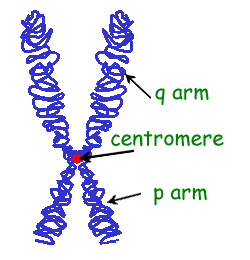|
What do they look like?
When a cell is not dividing (called the interphase of the cell cycle), the chromosome is in its chromatin form. In this form it is a long, very thin, strand. When the cell begins to divide, that strand replicates itself and winds up into shorter tubes. Before the split, the two tubes are pinched together at a point called the centromere. The shorter arms of the tubes are called the "p arms" and the longer arms are called the "q arms." |

|